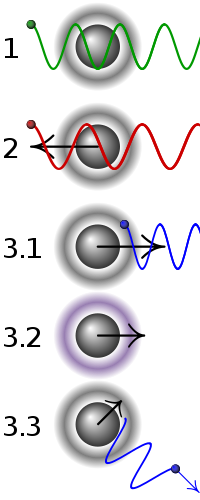
Back تبريد بالليزر Arabic Лазернае астуджэнне Byelorussian Refredament per làser Catalan Laserkøling Danish Laserkühlung German Enfriamiento láser Spanish سرمایش لیزری Persian Refroidissement d'atomes par laser French Fuarú le léasar Irish קירור באמצעות לייזרים HE

| 1 | A stationary atom sees the laser neither red- nor blue-shifted and does not absorb the photon. |
|---|---|
| 2 | An atom moving away from the laser sees it red-shifted and does not absorb the photon. |
| 31 | An atom moving towards the laser sees it blue-shifted and absorbs the photon, slowing the atom. |
| 32 | The photon excites the atom, moving an electron to a higher quantum state. |
| 33 | The atom re-emits a photon but in a random direction. The atom momentum vectors would add to the original if they were in the same direction but they are not so the atom has lost energy and, therefore, cooled. |
Laser cooling includes several techniques where atoms, molecules, and small mechanical systems are cooled with laser light. The directed energy of lasers is often associated with heating materials, e.g. laser cutting, so it can be counterintuitive that laser cooling often results in sample temperatures approaching absolute zero. It is a routine step in many atomic physics experiments where the laser-cooled atoms are then subsequently manipulated and measured, or in technologies, such as atom-based quantum computing architectures. Laser cooling relies on the change in momentum when an object, such as an atom, absorbs and re-emits a photon (a particle of light). For example, if laser light illuminates a warm cloud of atoms from all directions and the laser's frequency is tuned below an atomic resonance, the atoms will be cooled. This common type of laser cooling relies on the Doppler effect where individual atoms will preferentially absorb laser light from the direction opposite to the atom's motion. The absorbed light is re-emitted by the atom in a random direction. After repeated emission and absorption of light the net effect on the cloud of atoms is that they will expand more slowly. The slower expansion reflects a decrease in the velocity distribution of the atoms, which corresponds to a lower temperature and therefore the atoms have been cooled. For an ensemble of particles, their thermodynamic temperature is proportional to the variance in their velocity, therefore the lower the distribution of velocities, the lower temperature of the particles.
The 1997 Nobel Prize in Physics was awarded to Claude Cohen-Tannoudji, Steven Chu, and William Daniel Phillips "for development of methods to cool and trap atoms with laser light".[1]
- ^ "The Nobel Prize in Physics 1997". Nobel Foundation. Archived from the original on 7 October 2008. Retrieved 9 October 2008.
© MMXXIII Rich X Search. We shall prevail. All rights reserved. Rich X Search